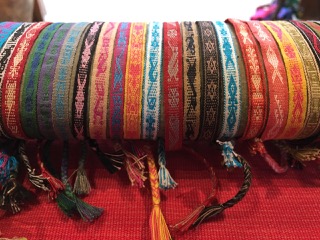Non-Western Art
Huichol Art
Wixárika are a group of indigenous people that originate from the San Andres, Santa Catarina and San Sebastian, Mexico but migrated to Jalisco and Nayarit after the arrival of the Spanish in the 16th century. The word Huichol didn’t begin into the 19th century and is a term used to refer to those that remained true to their religious beliefs after the Spanish colonization. Huichol art is very popular among tourist areas in Jalisco, Guadalajara and Puerto Vallarta Mexico. The deer, corn and peyote referred to as the trinity, are part of their religious beliefs and are seen throughout their art pieces. |
| Tutukila (1974) |
Yarn and beadwork are the most common types of art pieces created as Huichol art. Before the Spanish conquest beads were created from clay, bone, stone, coral, turquoise pyrite, jade and seeds before the introduction of glass beads. The introduction of beads and materials allowed for further creations and traditions to continue on and there is even a museum called Basilica of Our Lady of Zapopan opened by a priest named Ernesto Loera Ochoa. The purpose of the museum was to allow one artist, Ramon medina Silva to “represent the traditions and beliefs of his people”.
Their pieces vary from shoulder bags, beaded sculptures, headbands, and yarn “paintings”. Here we can see all the colorful yarn used instead of the typical paint that is most commonly used.
My family is from Nayarit, and I recently had an aunt send me some art pieces and jewelry with a note saying “to embrace my heritage”. Looking into these pieces was very interesting and deepened a connection to my heritage roots. I already own a couple pieces of Huichol art and I am excited for my visit to Puerto Vallarta this upcoming winter break, because now I can go on to collect more pieces while also understanding the connection this has to me and the Huichol people of central Mexico.
Wikimedia Foundation. (2021, November 27). Huichol Art. Wikipedia. Retrieved December 1, 2021, from https://en.wikipedia.org/wiki/Huichol_art.
Wixárika Research Center. (n.d.). Retrieved December 1, 2021, from https://www.wixarika.org/.







Comments
Post a Comment